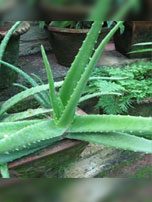SHAHEED KARTAR SINGH SARABHA AYURVEDIC MEDICAL COLLEGE & HOSPITAL
Affiliated to Guru Ravidas Ayurved University, Hoshiarpur Punjab
Affiliated to Guru Ravidas Ayurved University, Hoshiarpur Punjab

Family: Liliaceae
Introduction:
It is the one of the ayurveda medicinal plants widely using world wide as hair tonic. more than 50 species of plants are present in this genus. The extract kumarai sara in English it called Elio , used for helminthiasis, local application of painful swellings, chronic ulcer and ophthalmia.
Synonyms:
Kanyaasaara, Eleyaka (dried juice of the leaves). Kumaari, Kumaarikaa, Kanyaa, Grihkanyaa, Ghritkumaarika (plant).
A. vera Tourn. ex Linn.
A. indica Royle
A. littoralis Koening
Names in Different Languages:
English: Curacao Aloe, Barbados Aloe, Indian Aloe, Jaffarabad Aloe
Hindi: Ghikumar, Ghikumari
Kannada: Kathaligida
Malayalam: Kattarvazha
Sanskrit : KUMARI,GHRTAKUMARI
Tamil : Sotru Kattraazhai, Kumaari. Moosaambaram (dried juice), kattalai
Telugu : kalabanda
Unani : Gheekwaar, Sibr.
Folk : Elwaa, Musabbar (dried juice of leaves).
Varieties & adulterants – (CV – controversy, AD – adulterants) :
More than 50 species of plants are present in this genus it is not easy to identify for common people.
1. A.chinensis
Morphology:
A perennial plant with a short stem.
Leaves— 30-60 cm long, erect, crowded in a basal rosette, juicy, glaucous- green, narrow lanceolate , long acuminate, margins with spiny teeth.
Flowers— yellow, in dense racemes.
Fruits – loculicidal capsule
Aloe vera chinensis
Smaller Asiatic form, fleshy, lanceolate leaves 30 cm long and recurved at tips, rounded beneath, blue- green with white markings and whitish teeth; flowers orange.
Distribution & Habitat:
Cultivated throughout India.
Chemical constituents:
aloctin A (glycoprotein), aloenin (bitter glucoside), barbaloin, C-glycosyl chromone, chrysophanol glycoside; galactose, mannose; aldopentose, aloesin, aloesone, I-sitosterol, alocutin A & B, acemannan
Properties:
Rasa Tikta
Guna : Guru, Snigdha, Pichila
Virya: sita
Vipãka Katu
Karma : vãtahara, Caksusya, Vrsya, Brmhana, Rasayana, Bhedana .
Indications:
Yakrtodara, Plihodara, Gulma, Granthi, Agnidagdha Vrana, Jvara, Tvak roga, sula, Vibandha
Srotogamitva:
Dosha : vatha shaman
Dhatu : rasa, meda
Mala : purisha janaka
Organ : liver, spleen, uterus
Part used:
Leaf pulp juice, Dried leaf pulp
Dosage:
Leaf pulp juice—10–15 ml.
Dried leaf pulp juice—100–200 mg powder.
Internal uses:
Digestive system:Anthraquinone glycosides, known as aloin, in small doses act as a tonic to the digestive system, and at higher doses become a strong purgative, as well as increase colonic secretions and peristaltic contractions. Resin fraction is also as important as aloin in cathartic action. In A. barbadensis the highest percentage of aloin
Reproductive system:Aloe produces pelvic congestion and is used for uterine disorders, generally with Fe and carminatives. The pulp is used in menstrual suppressions.
Skin:Aloe gel can inhibit bradykinin, a pain-producing agent; C-glycosyl chromone appears to reduce topical inflammation. Aloe gel also slows or inhibits the synthesis of thromboxane, which may accelerate the healing of burns.
Important Yogas or Formulations:
Kumäryãsava, Rajahpravartani vati, Kumãrikã vati, Kumãri tailam
Therapeutic Uses:
(1) Pliha Vrddhi— Haridrã powder and juice of Kumäri are given
(2) Kamala — Kumãri svarasa as nasya (B.P.). (3) Apasmãra— Ghee prepared with Yastimadhu Kvãtha and Kumãri svarasa is useful
